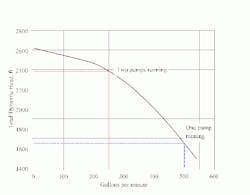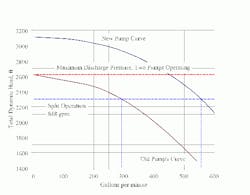Keep parallel pumps in line
|
Related articles |
In its hydrotreater (hydrogenation) unit, two identical eight-stage centrifugal pumps originally were installed: one for normal operation and the other as a spare. By operating both pumps, its possible to increase the available head because each pump has a lower flow rate. As the pump curve (Figure 1) shows, dropping the flow rate from 500 gpm through one pump to 250 gpm through each pump raises the total dynamic head (TDH) generated from 1,647 ft. to 2,342 ft.
Figure 1. Using two identical pumps to handle the same flow significantly boosts total dynamic head generated. (click to enlarge)
When putting two pumps in parallel, always bear in mind that even identical pumps dont necessarily have the same performance. As weve already covered (www.ChemicalProcessing.com/articles/2007/053.html), their pump curves can differ due to dissimilar maintenance histories, tolerances and wear and piping and layout differences also can have an impact.
Running the two pumps on the hydrotreater meant no spare was available. Hence, when one pump required maintenance unit capacity dropped. This eventually led to adding a third, larger pump. (Figure 2 includes the pump curves for the original pumps and the new pump.)
Figure 2. Parallel operation forced the older, smaller pump to run far from its best efficiency point. (click to enlarge)
The plan was to use the new unit as the main pump and keep the originals as spares because the smaller pumps would run at low percentages of design flow and thus at low efficiency. The idea was to keep the higher efficiency pump in service.
Over time, operation rates continued to be pushed and an attempt was made to use one of the old pumps in parallel with the new pump. However, this led to frequent maintenance problems on the smaller pump.
Analysis of non-identical pumps in parallel can be difficult. The key concept to keep in mind is that any connected flow path between two points must have equal pressure differentials between those two points. Because the suction and discharge conditions of all the pumps is identical, the pressure change between the suction and pressure must be the same.
So, analysis must start by putting the two pump curves on the same basis and then drawing a horizontal line across the pump curves at the known pressure (Figure 2).
The intersection of this line with each pump curve gives the flow rate through that pump. Here, at 2,300 ft. of head, 292 gpm goes to the old pump and 556 gpm to new pump for a total of 848 gpm.
For two pumps to operate in parallel, their TDHs must overlap. At zero flow the original pumps have a differential head of 2,619 ft. At discharge pressures higher than this, reverse flow may damage the pump and reduce overall system capability. Here, the new pump has the capability to deliver the higher head. In such cases when operating different pumps in parallel, make sure that reverse flow doesnt occur. Of course, most pumps start having reliability problems well before zero flow rates are reached.
The hydrotreater pumps were very poorly matched. When operating the new pump and one of the original pumps in parallel, the smaller pump was forced to operate at very low loads, far from its best efficiency point (~375 gpm). The long-term solution required modifying the new pump and replacing the original spares with a single unit fit for the service.
Andrew Sloley, contributing editor
[email protected]


